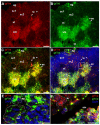Differential Expression of Duplicate Insulin-like Growth Factor-1 Receptors (igf1rs) in Medaka Gonads
- PMID: 35743889
- PMCID: PMC9225247
- DOI: 10.3390/life12060859
Differential Expression of Duplicate Insulin-like Growth Factor-1 Receptors (igf1rs) in Medaka Gonads
Abstract
Insulin-like growth factor-1 receptors (igf1rs) play important roles in regulating development, differentiation, and proliferation in diverse organisms. In the present study, subtypes of medaka igf1r, igf1ra, and igf1rb were isolated and characterized. RT-PCR results showed that igf1ra and igf1rb mRNA were expressed in all tissues and throughout embryogenesis. Using real-time PCR, the differential expression of igf1ra and igf1rb mRNA during folliculogenesis was observed. The results of in situ hybridization (ISH) revealed that both of them were expressed in ovarian follicles at different stages, and igf1rb was also expressed in theca cells and granulosa cells. In the testis, both igf1ra and igf1rb mRNA were highly expressed in sperm, while igf1rb mRNA was also obviously detected in spermatogonia. In addition, igf1ra mRNA was also present in Leydig cells in contrast to the distribution of igf1rb mRNA in Sertoli cells. Collectively, we demonstrated that differential igf1rs RNA expression identifies medaka meiotic germ cells and somatic cells of both sexes. These findings highlight the importance of the igf system in the development of fish gonads.
Keywords: gene expression; igf1rs; medaka; ovary; testis.
Conflict of interest statement
The authors declare no conflict of interest. The company had no role in the design of the study; in the collection, analyses, or interpretation of data; in the writing of the manuscript, and in the decision to publish the results.
Figures







Similar articles
-
Medaka igf1 identifies somatic cells and meiotic germ cells of both sexes.Gene. 2018 Feb 5;642:423-429. doi: 10.1016/j.gene.2017.11.037. Epub 2017 Nov 14. Gene. 2018. PMID: 29154873
-
The gsdf gene locus harbors evolutionary conserved and clustered genes preferentially expressed in fish previtellogenic oocytes.Gene. 2011 Feb 1;472(1-2):7-17. doi: 10.1016/j.gene.2010.10.014. Epub 2010 Oct 31. Gene. 2011. PMID: 21047546
-
Insulin-like growth factor receptor 1b is required for zebrafish primordial germ cell migration and survival.Dev Biol. 2007 May 1;305(1):377-87. doi: 10.1016/j.ydbio.2007.02.015. Epub 2007 Feb 21. Dev Biol. 2007. PMID: 17362906 Free PMC article.
-
Differential expression of IGF-I mRNA and peptide in the male and female gonad during early development of a bony fish, the tilapia Oreochromis niloticus.Gen Comp Endocrinol. 2006 May 1;146(3):204-10. doi: 10.1016/j.ygcen.2005.11.008. Epub 2006 Jan 18. Gen Comp Endocrinol. 2006. PMID: 16412440
-
[Reconsidering the roles of female germ cells in ovarian development and folliculogenesis].Biol Aujourdhui. 2011;205(4):223-33. doi: 10.1051/jbio/2011022. Epub 2012 Jan 19. Biol Aujourdhui. 2011. PMID: 22251857 Review. French.
References
-
- Wood A.W., Duan C., Bern H.A. Insulin-like growth factor signaling in fish. Int. Rev. Cytol. 2005;243:215–285. - PubMed
-
- Berishvili G., D’Cotta H., Baroiller J.F., Segner H., Reinecke M. Differential expression of IGF-I mRNA and peptide in the male and female gonad during early development of a bony fish, the tilapia Oreochromis niloticus. Gen. Comp. Endocrinol. 2006;146:204–210. doi: 10.1016/j.ygcen.2005.11.008. - DOI - PubMed
Grants and funding
LinkOut - more resources
Full Text Sources

